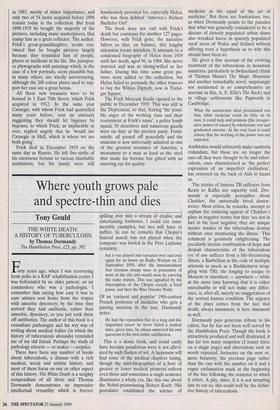Where youth grows pale and spectre-thin and dies
Tony Gould
THE WHITE DEATH: A HISTORY OF TUBERCULOSIS by Thomas Dormandy The Hambledon Press, £25, pp. 392 arty years ago, when I was recovering from polio in a RAF rehabilitation centre I was befriended by an older patient, an air commodore who was a pathologist. I remember him saying how easy it was to cure airmen sent home from the tropics with amoebic dysentery; by the time they arrived they had antibiotic, rather than amoebic, dysentery, so you just took them off antibiotics. The author of this book is a consultant pathologist and his wry way. of writing about medical follies (in which the history of tuberculosis abounds) reminded me of my old friend. Perhaps the study of pathology attracts — or makes — sceptics.
There have been any number of books about tuberculosis, a disease with a rich medical, social and artistic history, and most of them focus on one or other aspect of this history. The White Death is a weighty compendium of all three and Thomas Dormandy demonstrates an impressive intellectual versatility which is forever spilling over into a stream of erudite and entertaining footnotes. I could cite innu- merable examples, but two will have to suffice. In one he remarks that Chopin's funeral march was not played when the composer was buried in the Pere Lachaise cemetery, but it was played and repeated over and over again for six hours on Radio Warsaw on 23 September 1939, after the announcement that German troops were in possession of most of the city and would soon be entering the radio station. This was signalled by the interruption of the Chopin record, a brief pause, and then the Blue Danube Waltz.
Of an 'eminent and popular' 19th-century French professor of medicine who gets a passing mention in the text, Dormandy notes:
He had the reputation that in a long and dis- tinguished career he never failed a student since, given time, he always answered his own questions to his own entire satisfaction.
This is a dense book, and could easily have become ponderous were it not allevi- ated by such flashes of wit. A layperson will find some of the medical chapters taxing, though the mini-biographies of a host of greater or lesser medical pioneers enliven even these and sometimes a single sentence illuminates a whole era, like this one about the Nobel-prizewinning Robert Koch: 'His postulates established the science of medicine as the equal of the art of medicine.' But there are frustrations, too, as when Dormandy points to the paradox that what was generally considered to be a disease of densely populated urban slums also wreaked havoc in sparsely populated rural areas of Wales and Ireland without offering even a hypothesis as to why this should have been so.
He gives a fine account of the evolving treatment of the tuberculous in mountain sanatoria, particularly in Switzerland (think of Thomas Mann's The Magic Mountain and another remarkable novel, surprisingly not mentioned in so comprehensive an account as this, A. E. Ellis's The Rack) and in village settlements like Papworth in Cambridge.
What the sanatorium ideal proclaimed was that, while medicine could do little on its own, it could help and promote the recuper- ative power of nature] by wholesome rest and graduated exercise. At the very least it could ensure that the working of the power was not impeded.
Antibiotics would ultimately make sanitoria redundant, but these are no longer the cure-all they were thought to be and tuber- culosis, once characterised as 'the perfect expression of an imperfect civilisation', has returned on the back of Aids to haunt us.
The stories of famous TB sufferers from Keats to Kafka are superbly told. Dor- mandy is especially perceptive about Chekhov, the universally loved doctor- writer. Most critics, he remarks, attempt to explain the enduring appeal of Chekhov's plays in negative terms; but they 'are not in fact in the least negative: they are unique insider studies of the tuberculous destiny without once mentioning the illness'. This comment is genuinely enlightening. The peculiarly intense combination of hope and despair characteristic of the tuberculous (or of any sufferer from a life-threatening illness, a Barbellion in the coils of multiple sclerosis as much as a Bashkirtseva strug- gling with TB), the longing to escape to Moscow or elsewhere — anywhere — while at the same time knowing that it is either unrealisable or will not make any differ- ence, is, after all, merely an exaggeration of the normal human condition. The urgency of the plays comes from the fact that death, always immanent, is here imminent as well.
Dormandy pays generous tribute to his editor, but he has not been well served by the Hambledon Press. Though the book is attractively produced and well illustrated, it has far too many misprints (I found three on a single page) and aberrations such as words repeated, footnotes on the next or, more bizarrely, the previous page rather than the one with the number on it and a rogue exclamation mark at the beginning of the line following the sentence to which it refers. A pity, since, if it is not tempting fate to say so, this could well be the defini- tive history of tuberculosis.


























































 Previous page
Previous page